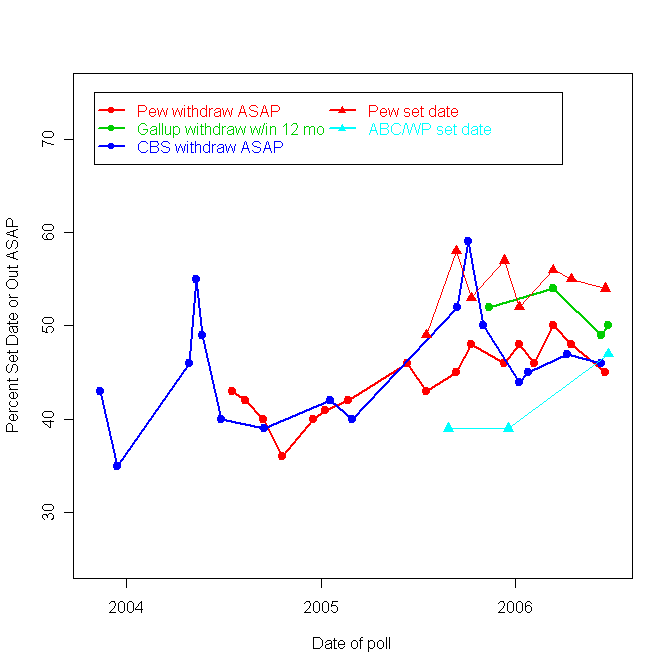A quick update to yesterday’s post: With the help of Prof. Charles Franklin, I bring you a chart showing the trend in five questions that have tracked attitudes on whether and when to withdraw U.S. troops from Iraq. As explained yesterday, these questions are far from identical: Some ask explicitly about a timeline for withdrawal, others ask more generally whether troops should be withdrawn “as soon as possible” or stay “as long as it takes” or “until the situation has stabilized.” Nonetheless, as Franklin’s chart illustrates, support for withdrawing troops sooner rather than later on these measures has tended to converge since mid-2005, with no sign of an overall trend.

Notice the way the two measures that showed the greatest support for leaving – the lines at the top of the graph – have trended downward since about October 2004, while the support for a withdrawal timeline as measured by ABC News and The Washington Post (the light blue line) has trended upward. The net result is that a roughly 20-point spread between the highest and lowest numbers in October 2005 has reduced to a roughly 10-point spread.
Thus my conclusion yesterday that as the debate on timelines and other proposals for withdrawal has intensified, real underlying attitudes have been hardening and are less susceptible to the variation in opinion poll question wording and context.
The other trend evident in the graphic is that support for withdrawing troops sooner rather than later has increased significantly since the 2004 elections (as measured by the two more generally worded questions from CBS News and the Pew Research Center). For example, in October 2004, Pew showed a 21 point net preference for keeping troops in Iraq “until the situation has stabilized” (57%) rather than bringing troops home “as soon as possible” (36%). On the most recent Pew survey, that preference narrowed to a net 5 points (50% to 45% — see Q52).
So while attitudes on withdrawing troops from Iraq appears to be hardening, Americans are more closely divided on whether to withdraw than they were in 2004.
UPDATE II: The Washington Post‘s Chris Cillizza has more about questions on a potential troop withdrawal in his weekly “Parsing the Polls” feature.
UPDATE III (6/29): As noted by DemFromCt in a comment below and on his site TheNextHurrah, Gallup’s Frank Newport has an analysis posted this morning that takes a close look at their questions on proposals to withdraw troops from Iraq:
A majority of Americans would like Congress to pass a resolution
addressing the withdrawal of U.S. troops from Iraq, but Americans are
split down the middle over whether that withdrawal should be based on a
dated timetable, or left open-ended. Meanwhile, a majority of Americans
continue to believe that U.S. involvement in Iraq was a mistake.
As with all Gallup.com analysis, Newport’s report is free for today, but available only to subscribers after that.
As I noted in my comment yesterday, adding in (not for analysis purposes by MP, but for ‘big picture’ context), Gallup has an analysis today by Frank Newport of Congressional preference, entitled “Americans Want Congressional Involvement in Iraq Decisions but no clear mandate in terms of a timetable for troop withdrawal”.
http://poll.gallup.com/content/?ci=23521
If Americans are divided (and clear in their minds that there is no consensus), it is interesting that they turn to Congress for guidance, and not the WH, and in doing so, want Dems to be elected.
http://poll.gallup.com/content/?ci=23509
Whatever the polls seem to indicate on the narrower Iraq question, I’m not so sure the “stay the course” people are all that happy with that choice. Are there any ‘intensity’ questions like the ‘strongly approve’, ‘strongly disapprove’ the WaPo uses in their presidential approval poll?